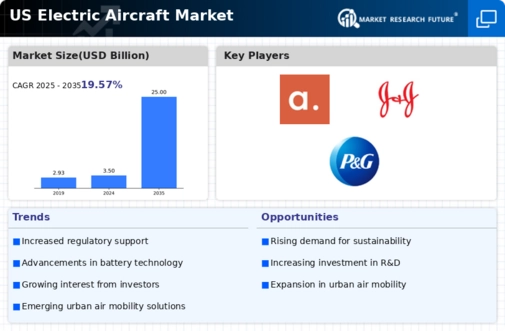Government Incentives and Funding
Government incentives and funding play a critical role in shaping the electric aircraft market. Various federal and state programs are designed to support the development and deployment of electric aviation technologies. For instance, the US government has allocated substantial funding through initiatives like the Sustainable Aviation Fuel Grand Challenge, which aims to promote the use of sustainable aviation fuels and electric aircraft. These financial incentives not only lower the barriers to entry for new players in the market but also encourage existing manufacturers to innovate and expand their electric aircraft offerings. As a result, the electric aircraft market is likely to benefit from increased competition and technological advancements, fostering a more dynamic industry landscape.
Environmental Sustainability Initiatives
The electric aircraft market is experiencing a surge in interest due to increasing environmental sustainability initiatives. Governments and organizations are prioritizing the reduction of carbon emissions, which has led to a growing demand for cleaner aviation solutions. In the US, the Biden administration has set ambitious targets to achieve net-zero emissions by 2050, which includes significant investments in electric aircraft technology. This focus on sustainability is likely to drive innovation and adoption within the electric aircraft market, as manufacturers seek to align with these environmental goals. Furthermore, the market is projected to grow at a CAGR of approximately 15% over the next decade, indicating a robust shift towards eco-friendly aviation solutions.
Rising Fuel Costs and Economic Pressures
Rising fuel costs and economic pressures are driving interest in the electric aircraft market. As traditional aviation fuel prices fluctuate, airlines and operators are increasingly seeking alternative solutions to mitigate operational costs. Electric aircraft present a viable option, as they typically offer lower energy costs and reduced maintenance expenses compared to conventional aircraft. The potential for significant savings on fuel can be a compelling factor for airlines looking to enhance profitability. Additionally, as the electric aircraft market matures, the cost of ownership is expected to decrease, making electric aircraft an attractive proposition for a broader range of operators. This economic shift is likely to accelerate the transition towards electric aviation.
Technological Innovations in Battery Systems
Technological innovations in battery systems are pivotal for the electric aircraft market. Advances in energy density, charging speed, and overall efficiency of batteries are crucial for enhancing the performance of electric aircraft. The development of solid-state batteries, for instance, could potentially double the energy density compared to traditional lithium-ion batteries, thereby extending the range and operational capabilities of electric aircraft. As battery technology continues to evolve, it is expected that the electric aircraft market will witness a significant transformation, with manufacturers increasingly investing in research and development. This focus on battery innovation is likely to attract further investment, as stakeholders recognize the potential for improved performance and reduced operational costs.
Public Awareness and Demand for Green Technologies
Public awareness and demand for green technologies are influencing the electric aircraft market. As consumers become more environmentally conscious, there is a growing expectation for industries, including aviation, to adopt sustainable practices. This shift in consumer sentiment is prompting airlines to explore electric aircraft as a means to enhance their green credentials. Furthermore, public pressure is leading to increased scrutiny of carbon emissions from air travel, which may compel airlines to invest in electric aircraft to meet consumer expectations. The electric aircraft market is thus positioned to benefit from this heightened demand for sustainable aviation solutions, as manufacturers respond to the evolving preferences of environmentally aware consumers.

















Leave a Comment